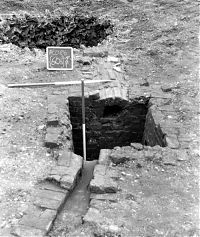Drain Drain Go Away....
- By: Gary Webster |
- Apr 16, 2008
- Share
- del.icio.us


Geaorgian drainage system. Front to back: Culvert leads to square silt trap leads to covered culvert leads to horn core pit soak-away.
Cleaning back around the new horn-core pit revealed another feature, a drainage system, consisting of three different sections. There was the small passage running between two rows of bricks, and bottomed by what appeared to be reused roof tile. This allowed the water to flow down to the next section which was a silt trap. The general idea behind this would be for the water to run in and settle slightly in this deep, bricklined pit. The silt would then clear from the water, as it is heavier and it would slowly sink to the bottom. The clean water would then leave via a culvert pipe, which was higher in the silt trap than the intake on the other side. This filtered then into the horn core pit. This entire system could be used in a bid to try and stop the horn-core pit from becoming unusable from being silted up. The silt trap, being shallower, would be easier to empty.
The system would have been larger, had it not been truncated by the later piping that ran over roughly the same area. It was quite interesting to see the interaction between this drain and the horn-core pit, and we have yet to determine if they are contemporary in construction, or whether the drain was knocked through into the horn-core pit later.
One thing we have to bear in mind when dealing with things such as drains, is the amount of times an ‘event’ has occured in the same space. If there was a drainage issue in one place 200 years ago, there is a good chance a similar issue existed in the same spot earlier still, and the drain is an act of modernization. Removing the drain and seeing what features it has been cut into is a good way of seeing if the area has been used before.